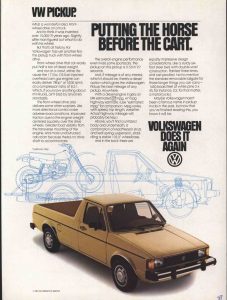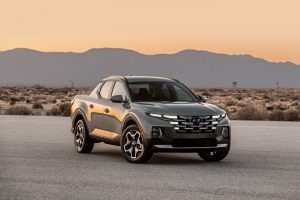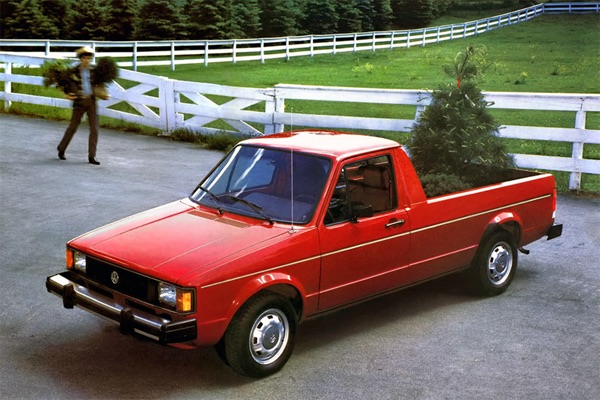The mini-truck is back – it’s just not really a truck. And it’s not a new concept, either.
But that doesn’t mean it’s not a good idea.
Some less-than-spring-chickens will recall the Volkswagen Rabbit pickup that went on sale back in 1979. It was what its name suggests – a VW Rabbit (which was a car) with a bed (like a truck). It emulated the car-as-truck idea pioneered years earlier by the Chevy El Camino and the Ford Ranchero – though those two were based on big cars and the Rabbit was tiny. But the idea was basically the same: Make a car more like a truck for people who don’t want to drive a truck – especially a big truck – but need some truck-like attributes, chiefly the ability to truck a bunch of stuff around in the bed.
That idea is making a comeback.
Hyundai just launched the Santa Cruz and Ford has the Maverick. Like the old VW Rabbit pickup, they look like small trucks but their layout is all car underneath.
Well, most modern cars’ layout.
They are mostly are front-wheel-drive and so are these two – and so was the old Rabbit pickup. But unlike the Rabbit pick-up, these two also offer AWD, which the Rabbit didn’t. Either way, it’s beside the point – which is that these kinds of vehicles fill a void left by the disappearance of small actually trucks, which no one makes anymore.
Check that.
No one sells them here anymore.
Compact pick-ups are abundant practically everywhere else. In the United States, the smallest trucks you can get are models like the current Ford Ranger and Chevy Colorado and Nissan Frontier – all of which are nearly full-sized trucks, by the historical standards defining a full-sized truck. 
By relatively recent standards.
In 2000, a Ford F150 regular cab with the standard (six foot) bed measured 207.2 inches bumper to bumper. A 2021 Ford Ranger is 210.8 inches long, end to end, with the same size bed. The no-longer-made compact-sized Ranger (last sold new in 2011) was only 189.4 inches long overall – and much less wide (69.3 inches) vs. the current Ranger (73.3) and F150 (79.9 inches).
The trucks you can still buy are also very tall.
A new (nearly full-sized) Ranger stands 71.5 inches high; the old (compact) Ranger was just 66.2 inches high. The new F150 stands 77.2 inches high. The bed walls of the new trucks are also several inches higher than was formerly usual, compounding the height problem to such an extent that many new trucks literally come with step ladders built into the tailgate so as to make it feasible to get into the bed and to get things out of the bed, without resorting to a forklift.
The long and short (and high) of it being that these trucks can be a bit much for some, who would otherwise be inclined to buy a truck – and used to buy them, when the more manageable ones were still available.
So why are they no longer available?
The chief reason is they’re less profitable.
Why would Ford want to sell you an $18,600 Ranger – the base price of the 2011 model – when they can sell you a $24,820 Ranger (the base price of the 2021 Ranger). The other reason has to do with something called the Chicken Tax, an arcane piece of leftover tit-for-tat trade war tariffing from the ’60s that applies a heavy tax to imported small trucks – and most of the small trucks still made are made outside the United States. Bringing them into the United States would be expensive – or rather, reduce the profit margin relative to models made here, on account of the tax.
And so they aren’t sold here.
But that leaves people who like the idea of a smaller truck in the lurch. It’s a gap that new models like the Santa Cruz and Maverick are hoping to fill and likely will.
The Maverick has a base price of just $19,995 – which is significantly less, in inflation-adjusted fiat currency, than what Ford was asking for the 2011 Ranger, which was about the same size (and height). Hyundai hasn’t announced pricing yet for the 2022 Santa Cruze – but it should be in the same ballpark and both will be what small trucks used to be, in terms of being easy to deal with.
And to load/unload.
The only downside being they aren’t actually trucks and so haven’t got a truck’s ability to go off-roading (no 4WD, no two-speed transfer case or Low range gearing) and aren’t really designed to carry – or pull – heavy loads, like a truck.
But then, neither was the old Rabbit pick-up not-really-a-truck.
A good idea always works, no matter what you call it.
. . .
Got a question about cars, Libertarian politics – or anything else? Click on the “ask Eric” link and send ’em in!
If you like what you’ve found here please consider supporting EPautos.
We depend on you to keep the wheels turning!
Our donate button is here.
If you prefer not to use PayPal, our mailing address is:
EPautos
721 Hummingbird Lane SE
Copper Hill, VA 24079
PS: Get an EPautos magnet or sticker or coaster in return for a $20 or more one-time donation or a $10 or more monthly recurring donation. (Please be sure to tell us you want a magnet or sticker or coaster – and also, provide an address, so we know where to mail the thing!)
My eBook about car buying (new and used) is also available for your favorite price – free! Click here. If that fails, email me at [email protected] and I will send you a copy directly!












It may have been good to mention that these two new offerings from Ford and Hyundai will be competing with the Honda Ridgeline which has been on the market for some time.
Hi Brad,
True! Credit to Honda for the Ridgeline; also to Subaru – for the Baja (though it failed). It will be interesting to see how these two do…
I had to take the Cherokee to the dealer last week for a transmission recall. I got a Gladiator loaner, which basically qualifies as a mini truck without the advantages of a mini truck. Being a Jeep, it had all the squeaks, ride and claustrophobia of a Wrangler, but with terrible gas mileage and illusion of having usable space in the back. The bed is so shallow I don’t think you could stash a bicycle in the back, let alone anything like a quad or pair of dirt bikes.
Looked cool in the driveway though, so I guess that’s all that matters.
Back in the aughts, I remember hearing about an older guy who had a VW Rabbit diesel pickup that he was running on pure vegetable oil for years. Not bio-diesel as is required by more refined engines, just used cooking oil that he got from the local restaurants.
Some junior reporter from the local rag ran a human-interest story in him and he proudly laid out all the details. How many years, how many miles, etc.
Well, you can write the rest. Some local bureaucrat did the math and turned it over to the collection agencies and they sent him a bill for $2,300, which is the amount, they estimated, of road tax that he failed to pay in that time.
This proud WWII vet got a crash course in what he and his buddies actually fought and died for.
Hey Baxter,
“…the local rag ran a human-interest story in him”.
Man, that must have hurt.
Cheers,
Jeremy
Pfff, what?! That’s some BS, man. If I were him, I think I might’ve lost it at that point and gone Nazi hunting one more time.
I’m sorry, but a truck called “Maverick” is just weird. A Maverick is a compact, rear-drive meat-and-potatoes car.
No, it’s the call sign of a fictitious fighter jock portrayed by a closeted-gay dwarf.
The stuff that we are towing is getting bigger also. Have you checked out the RV’s on the market? I still camp in an almost 30 year old popup trailer. It is by modern standards, bare bones, and once a large unit, now quite small by modern standards. The new units are loaded with creature comforts that all add weight to the camper. The hard side units are massive; there are fifth wheel units that can sleep ten with full kitchens. So you need a big truck to pull these monsters down the road. I also feel that besides being a little spoiled and having perceived needs for all this stuff, many Americans are insecure and feel they need something big to protect them from a frightening world. Of course there are men that are trying to make up for a deficient in other areas – if you know what I mean.
The RV industry is crowing about their current windfall, blaming COVID and social distancing. They’re really ignoring the real reason which I speculate is would-be homebuyers priced out of the market. They’re able to work remotely, or at least can camp on BLM land close enough to their workplace that they can live in a trailer. Yes there are plenty of upper-middle class people who can afford toy haulers now that the house is paid for, but I would think that’s still a fairly constant percentage of the population.
A few years back I went to the RV show in Denver. There’s some really amazing stuff at the high end, but there’s also a lot of junk at the midrange that just looks terrible. Instead of putting all that effort into slide outs and fake fireplaces, why not come up with ligher cabinetry? Oh, because the amish labor building them doesn’t understand carbon fiber…
Wow, these human resource firms that make cars on the side are actually going to make something the public wants? My bet is they will become electric trucks with a payload that can take you 50 miles.
I will keep my 2008 Ranger until it dies. I wish I could have kept my 2001, but it gave up the ghost a few years ago. It had the 2.5L 4 banger, and 5 speed manual, and I could coax about 25mpg out of it if I was careful. This one has the 3.0V6 automatic, and it sucks down fuel at an alarming rate, averaging about 19mpg. Not terrible, but for its size, and compared to new trucks, its pretty bad. But, it is a real truck, and the perfect size for what I need making occasional stops at Lowes. It sits low, and I can put things in its bed without a problem, unlike the jacked up monstrosities that pass for trucks today.
I’ve been laughing for awhile now off and on about that fella awhile back who commented, “Oh, Oh, Eric…” in his Cartman voice. Crack. me. up.
Now it’s my turn, sorta. I actually drove a Rabbit once, not the pickup, but the car is pretty much the same danged thing. That car was Da Bomb! In the small car world, anyway. Simple dash, simple controls, just functional no nonsense, no frills, get-the-job-done automobile.
Right now, I’d Love to have a Rabbit-like pickup. The frame of my ’94 Toyota pickup (Not Tundra or DX, just, ‘pickup’) finally rotted through near the rear wheels. I’m debating doing some wielding repairs in order to squeeze a few more miles out of it, it has been perfect for me for most loads and things and fits in parking slots and through the gaps between trees and such, it’s very hard to give it up to the rust Blob.
Thanks for the article, Eric. Kinda sounds like what I’d be looking for, a truck to just get around town in and haul a few things without the huge pricetag, 4WD that I may not need, or jacked up nonsense. But I still won’t buy a new vehicle. Not if they spy on you or have “assist” features that I can live without.
Both of these new trucks just look like crossovers in which they cut off the roof of the hind end to make a “bed”. Nice try, but… Take a look at the Rabbit truck. It looks like the bed is still a good 5′ long, and it could be used like a truck. The Santa Cruz, here, has a bed that looks to be about 3′ long, maybe. It’s basically a car trunk with no lid. Just not giving me the warm fuzzies of pragmatism.
It’s about damn time too!
Not everybody needs to tow a house or spend a mortgage downpayment on a truck that can. What a great many people do need is a versatile vehicle that can haul your household or apartment-dweller necessities just as well as being a comfortable efficient commuter. The 2wd hybrid maverick is said to get 40mpg. This segment might very well knock the ubiquitous crossover off its perch. Having no domestic pickup offerings it’s easy to see why hyundai is offering their ute. One has to ask why ford is willing to risk taking a bite out of their bread and butter F trucks. Perhaps they’ve seen through the looking glass a future of banned or economically unfeasible full size trucks? Maybe full size sales are beginning to wilt due to outrageous prices that financiers are becoming hesitant towards. As the economic sinkhole scours an ever increasing amount of stability from underneath our feet a fuel sippy utility is going to be desperately needed by many. I hope they make a shitload of these things.
The Dodge Dakota was the perfect size truck for those who did not want or need a full size truck. It was midway between the “mini-trucks” of the day and the full-size trucks.
If Dodge resumed making the Dakota size trucks I would buy one today.
I recently bought a 94 Dodge Dakota for my daughter to drive when she turned 16. Only 130,000 miles on the V6. Should last her a while if she treats it well.
They are still out there.
I wore out a Dakota starting in 89. Being a plumber, it was the perfect size for one man to work out of, although my former faith in Mopar power trains was sorely misplaced. Transmission cooked at 50k, fortunately still under warranty. It was 4wd with bed height the same as 2wd, exactly the opposite of what you see now. I’ve got a 97 Tacoma now, and don’t work construction anymore. Regarding compact trucks such as my old Tacoma, they run circles around full size off road, getting into, and out of much tighter spots. Even has a button on the dash to turn off the clutch switch so you can start it in gear if needed, like one rear wheel hanging off the edge of a cliff.
What aggravated me about the Dakota was that it lacked 1.5″ between the wheel wells to drop a sheet of plywood on the floor. I suspect by design, to maintain full size sales. I found no reason, and no one is going to convince me they couldn’t have taken .75″ out of tire space so you could.
I totally forgot, I owned one of those Dakotas back in the early 90’s.
That wasn’t a half-bad little pickup.
… Wish I had it now.
I currently own a 2001 Dakota, and I’ve owned two Rangers. They were all fantastic, simple, useful trucks. Yes, the Dakota is a bit wider, but the second generation Ranger (or third, depending on how you count) had more legroom and more room behind the seat.
My current Dakota is a rare base model with the 2.5 Kenosha Jeep motor and a New Venture 5-speed manual. 204,000 miles on it and it burns no oil. A very handy truck for zipping around town and blasting down back roads. It’s not fast by any means, but it “fits” perfectly like a well-worn pair of old boots. Bought it for $1900 — eight years ago. Yes, I’ve had to do plenty of work on it to keep it going, but it’s easy and cheap to work on.